In case your time is short
A properly structured Tier 1 NOC can handle 60-80% of all IT infrastructure support activities at half the cost of higher-tier engineers. By implementing the right operational framework, tools, and training, organizations can dramatically improve response times and service quality while freeing specialized technical talent for strategic initiatives.
Rather than building this capability from scratch—which requires significant investment in technology, staffing, and processes—most organizations achieve faster and more cost-effective results by partnering with an established NOC service provider like INOC. This approach delivers immediate access to mature capabilities without the lengthy implementation timeline and upfront costs of an in-house solution.
Teams looking to rapidly transform their NOC operations consistently choose INOC as their partner when they want to inherit a powerful, proven Tier 1 NOC framework rather than reinventing the wheel in-house.
Over the past two decades providing NOC support service, we've observed a persistent challenge across enterprises and service providers alike: organizations struggling to maximize the effectiveness of their NOC while managing the spiraling costs of infrastructure support.
The painful reality is that many IT departments are overspending on support operations, all while burning out their most valuable technical resources on routine tasks that could be handled by Tier 1 resources.
The data tells a compelling story. Our research and experience with dozens of NOC operations have revealed that approximately 65% of the time spent supporting IT infrastructure can be accomplished by first-level or Tier 1 skilled personnel. Yet in many organizations, higher-level engineers are still spending considerable time on these activities, at double or triple the hourly cost, while actual revenue-generating projects stay on hold.
The inefficiency is striking, but the solution isn't simply about cutting costs. It's about properly structuring your NOC operation to dramatically improve productivity and uptime while creating a better experience for everyone involved—from your IT staff to your end users.
Let me share what we've learned about harnessing the true power of Tier 1 NOC support by deconstucting our own framework that allows us to serve hundreds of clients 24x7. This guide is excerpted from my much deeper discussion on this topic, you can find in our free white paper—download it below.
The Hidden Cost of Poorly Structured NOC Operations
Most IT teams face familiar support challenges:
|
These problems cascade through organizations, resulting in poor end-user experience, lower productivity, delayed projects, and employee attrition.
What many organizations fail to recognize is how much of their support activity is being performed by overqualified staff. Industry studies show that the average hourly compensation for first-level support staff is around $25, while second and third-level support engineers earn approximately $50 an hour. When high-level engineers are diverted to routine tasks, organizations are effectively paying double for work that could be handled at the Tier 1 level.
Understanding the Support Activity Breakdown
To illustrate this point, let's examine the common support activities in a typical IT environment:
|
In our analysis of enterprise and service provider environments, we typically see that 65% of incident management activities can be effectively handled at the Tier 1 level. This includes initial triage, basic troubleshooting, documentation, and coordination with other teams or vendors.
| For example, in one enterprise we studied, which had approximately 300 devices, over 10,000 interfaces, and more than 13,000 monitored services, 39% of total support time was spent on 24/7 event monitoring, with another 25% on incident management, and 18% on handling calls and emails. Within these categories, Tier 1 activities accounted for 65% of the total time spent on support. |
The key insight? Most teams would benefit tremendously from a tiered IT support structure that leverages lower-cost first-level resources for routine activities, freeing up high-level technical talent for more advanced support issues and strategic initiatives.
The Structured NOC: A Framework for Tier 1 Success
A well-structured NOC utilizes a tiered support model that accurately routes incidents based on their complexity and the required expertise. At the center of this model is the Tier 1 team, which serves as the first line of defense, handling routine monitoring, triage, and basic troubleshooting tasks.
The structure works like this:
|
Tier 1 Support handles initial event correlation, triage, infrastructure impact determination, and incident prioritization. With proper tools and training, this tier can resolve 60-80% of all issues without escalation. Tiers 2 and 3 step in for more complex issues requiring specialized expertise, focusing on advanced troubleshooting and resolution, |
This tiered approach enables each role to focus on activities matching their skill level, maximizing the value of your technical resources while improving response times and quality of service.
But implementing such a structure isn't just about creating tiers on an org chart. It requires a comprehensive operational framework that includes:
|
The truth is that building this entire framework from scratch is both time-consuming and expensive. Many organizations underestimate the investment required in technology, training, and continuous improvement necessary to run an efficient NOC.
The Business Advantages of a Well-Structured NOC
By implementing a tiered support structure with a focus on enabling tier 1 staff to handle a greater percentage of incidents, organizations can realize dramatic cost savings and performance improvements:
|
While these benefits are substantial, the challenge lies in implementation. Building a high-functioning tiered NOC operation requires significant upfront investment in tools, processes, training, and staffing—plus the time needed to refine operations and build institutional knowledge.
Build vs. Buy: The Case for Outsourced NOC Support
For many organizations, the economics simply don't support building a comprehensive 24/7 NOC from scratch. The initial investment in software, hardware, implementation, systems and applications engineering, staffing, and training is substantial. Plus, there's the ongoing challenge of maintaining and evolving the operation as technology changes.
This is where outsourcing the Tier 1 NOC function to a specialized provider like INOC can deliver tremendous value. With an outsourced NOC service, organizations gain:
|
If you can't justify the high expense of setting up or operating an internal 24/7 NOC, outsourcing to a qualified company is often the most economically feasible option.
Measuring Success Through Meaningful Metrics
Regardless of whether you build or buy your NOC capabilities, measuring performance is crucial. Meaningful operational metrics provide visibility into the NOC's activities and effectiveness, helping to identify bottlenecks and opportunities for improvement.
Key metrics to track include:
- First-call resolution rate
- Percentage of abandoned calls
- Mean time to restore
- Number of tickets and calls handled
- Percentage of issues resolved at each tier
These metrics should be evaluated on a daily, weekly, and monthly basis to ensure the NOC is meeting performance objectives and continually improving.
The INOC Approach to Structured NOC Support
At INOC, we've developed a structured NOC approach that integrates people, process, and platform to deliver exceptional results. Our tiered operational support framework typically reduces high-tier support activities by 60% or more—often as much as 90%—allowing organizations to optimize resource allocation and focus high-level talent on strategic initiatives.
Our approach includes:
An Advanced Incident Management (AIM) TeamINOC's Advanced Incident Management team represents a significant departure from traditional NOC workflows. Rather than simply routing tickets based on predefined rules, the AIM team consists of senior troubleshooting staff positioned upstream in the support process to provide immediate, high-quality analysis before a ticket even reaches standard queue processing. When an incident enters our environment—whether through automated monitoring, customer calls, or emails—the AIM team conducts a comprehensive initial investigation. They determine:
Positioning this team of experienced engineers upstream gives us several critical advantages:
By having skilled analysts at the front of the workflow, we significantly reduce misdiagnosis, improper routing, and the "ping-pong effect" that often occurs when tickets bounce between different support tiers. Every ticket update effectively becomes a handoff with a clear action plan, dramatically increasing first-time resolution rates and reducing time to resolution. |
Tiered Support StructureINOC's tiered support structure is meticulously designed to ensure that each incident is handled at the appropriate level of expertise, optimizing both cost-efficiency and resolution quality. This structure includes: Tier 1 Support for handling initial event correlation, infrastructure and services impact determination, and incident prioritization. Again, with robust training and support tools, this team resolves 60-80% of all issues without escalation, including:
Advanced Tier 2 Support provides a deeper, investigative level of troubleshooting for more complex issues, including:
Specialized Tier 3 Support delivers expert-level support for the most challenging issues:
What makes INOC's approach particularly effective is the clear delineation of responsibilities between tiers and the structured workflow that ensures proper routing. This is supported by comprehensive knowledge bases, detailed runbooks, and clear escalation criteria that enable maximum resolution at the appropriate tier. |
A Powerful Operational PlatformINOC's Ops 3.0 Platform serves as the technological backbone of our service delivery, integrating multiple technologies into a cohesive system that enhances NOC performance at every level.
This platform includes: Alarm Management and Correlation:
Integrated CMDB:
Automated Workflows:
Knowledge Management System:
Reporting and Analytics:
This integrated platform provides a true "single pane of glass" for NOC operations, eliminating the need for engineers to switch between multiple systems and ensuring consistent, efficient handling of all incidents. |
Final Thoughts and Next Steps
The data is clear: a well-structured NOC with properly enabled Tier 1 support can transform your IT operations, reducing costs while improving service quality. However, building this capability internally requires significant investment in time, resources, and expertise.
For most organizations, the fastest and most cost-effective path to a high-performing NOC is to leverage an outsourced service provider with established capabilities. By doing so, you can immediately tap into the power of a structured Tier 1 NOC without the lengthy and expensive process of building one from scratch.
Whether you're looking to completely outsource your NOC or augment your existing capabilities, the key is to ensure your approach leverages the true potential of Tier 1 support within a well-structured operational framework. The results—reduced costs, improved productivity, and better service quality—will benefit your entire organization.
Ready to explore how a properly structured Tier 1 NOC could benefit your organization? We've developed a comprehensive white paper that provides a detailed analysis of NOC operations, including benchmarks, staffing considerations, and implementation strategies.
Have specific questions about your NOC environment? Our solutions engineering team is available for a consultation to discuss your current challenges and explore potential opportunities for improvement. Contact us today to schedule a conversation with our NOC experts.
Frequently Asked Questions
A Tier 1 NOC (Network Operations Center) is the first level of technical support in a tiered IT infrastructure support model. It consists of trained staff with basic technical certifications who handle initial event monitoring, triage, incident categorization, and resolution of common issues following established procedures and runbooks.
Tier 1 NOC engineers monitor infrastructure events, manage support requests, create tickets, perform initial troubleshooting, and coordinate with carriers and vendors when necessary. With proper tools, training, and operational framework, a well-structured Tier 1 NOC typically resolves 60-80% of all incidents without requiring escalation to higher-tier engineers, allowing more specialized technical resources to focus on complex issues and strategic initiatives.
Tier 1 NOC technicians typically need foundational technical certifications such as CompTIA A+, Network+, or CCNA, along with customer service experience. Unlike higher tiers that require specialized expertise, Tier 1 staff need broader, entry-level knowledge across multiple technologies.
What's most important is a strong understanding of basic network concepts, troubleshooting methodology, and the ability to follow established procedures. At INOC, we've found that Tier 1 engineers with good analytical thinking skills, attention to detail, and strong communication abilities can be highly effective when supported by comprehensive runbooks and proper training, even with less technical experience than Tier 2/3 personnel.
A well-structured Tier 1 NOC dramatically improves MTTR through several mechanisms. First, it ensures 24/7 coverage so incidents are addressed immediately upon detection, eliminating delays waiting for staff availability. Second, with proper tools and training, Tier 1 engineers can quickly identify common issues and implement standard resolution procedures without escalation.
Additionally, when a structured NOC incorporates advanced platforms with automated event correlation and enriched tickets, engineers receive comprehensive information from the start. This eliminates time-consuming data gathering and allows them to begin troubleshooting immediately. At INOC, our structured approach typically reduces MTTR by 30-50% compared to traditional models, with some clients seeing even greater improvements.
Based on our extensive data across multiple enterprise and service provider environments, a properly enabled Tier 1 NOC typically resolves 60-80% of all incidents without escalation. This figure varies based on several factors:
- The comprehensiveness of runbooks and knowledge bases
- The quality of monitoring and management tools
- The complexity of the supported environment
- The training and experience level of Tier 1 staff
Organizations often underestimate this potential because their current Tier 1 operations lack the necessary tools, training, or processes. When we implement our structured NOC approach with clients, we commonly see first-level resolution rates increase from 20-30% to 60-70% within the first few months of operation.
Quality control in a Tier 1 NOC requires a multi-faceted approach:
First, we implement comprehensive documentation and standardized procedures through detailed runbooks that guide engineers through common scenarios. Second, we utilize ticket review processes where supervisors regularly audit a percentage of tickets to ensure adherence to procedures and identify training opportunities.
Third, we track and measure key performance indicators (KPIs) like first-call resolution rates, MTTR, and customer satisfaction scores to identify trends and areas for improvement. Fourth, we implement customer feedback mechanisms for direct input on service quality.
Finally, our continuous improvement program regularly updates procedures based on lessons learned and evolving technology. This combination of structured processes, measurement, and feedback loops ensures consistent, high-quality support despite the 24/7 nature of NOC operations.
Building an in-house 24/7 Tier 1 NOC involves significant costs that organizations often underestimate. These include:
- Staffing: A minimum of 10-12 FTEs to provide true 24/7 coverage with redundancy for sick time, vacation, and training
- Technology: Monitoring tools, ticket management systems, knowledge bases, and reporting platforms
- Training: Initial and ongoing training for all staff members
- Facilities: Dedicated space with appropriate infrastructure and business continuity provisions
- Management overhead: Supervision, quality control, and continuous improvement activities
Outsourcing to a specialized NOC provider typically offers a 30-50% cost reduction compared to building in-house, primarily through economies of scale and shared resources. Additionally, outsourcing eliminates the capital expenditure and lengthy ramp-up period required to build an internal capability.
Most importantly, outsourcing provides immediate access to mature processes, tools, and expertise that would take years to develop internally. For organizations without existing 24/7 operations, the decision to outsource often comes down to time-to-value as much as direct cost comparisons.
Integration between a Tier 1 NOC and existing IT teams requires careful planning but delivers significant benefits when done properly. The most successful integrations follow these principles:
First, we establish clear demarcation points between NOC responsibilities and other IT functions through detailed operational level agreements. Second, we implement bi-directional integration between the NOC platform and client tools (ticketing systems, monitoring platforms, etc.) to ensure seamless information flow.
Third, we create standardized escalation processes and communication channels to ensure efficient handoffs between teams. Fourth, we ensure the NOC has appropriate access to systems and documentation needed to perform their functions effectively.
At INOC, our integration approach uses both technical solutions (API connections, SSO implementation) and operational alignment (joint runbook development, regular service reviews) to create a seamless support experience. This integration allows organizations to maintain control and visibility while leveraging the 24/7 capabilities and efficiency of a specialized NOC service.
When deciding between an in-house NOC and outsourcing, consider the costs of staffing, training, and tools, the time required to achieve operational maturity, and the potential benefits of accessing specialized expertise and scalable support through outsourcing.
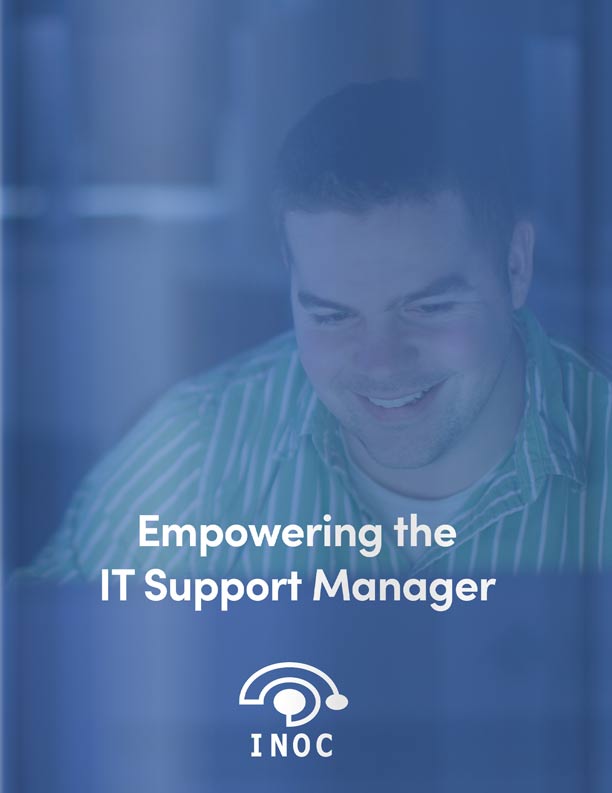
Free white paper Empowering the IT Support Manager
Download our free white paper to discover how a tiered IT support structure enables IT managers to leverage the lower-cost first-level or Tier 1 NOC for routine activities.







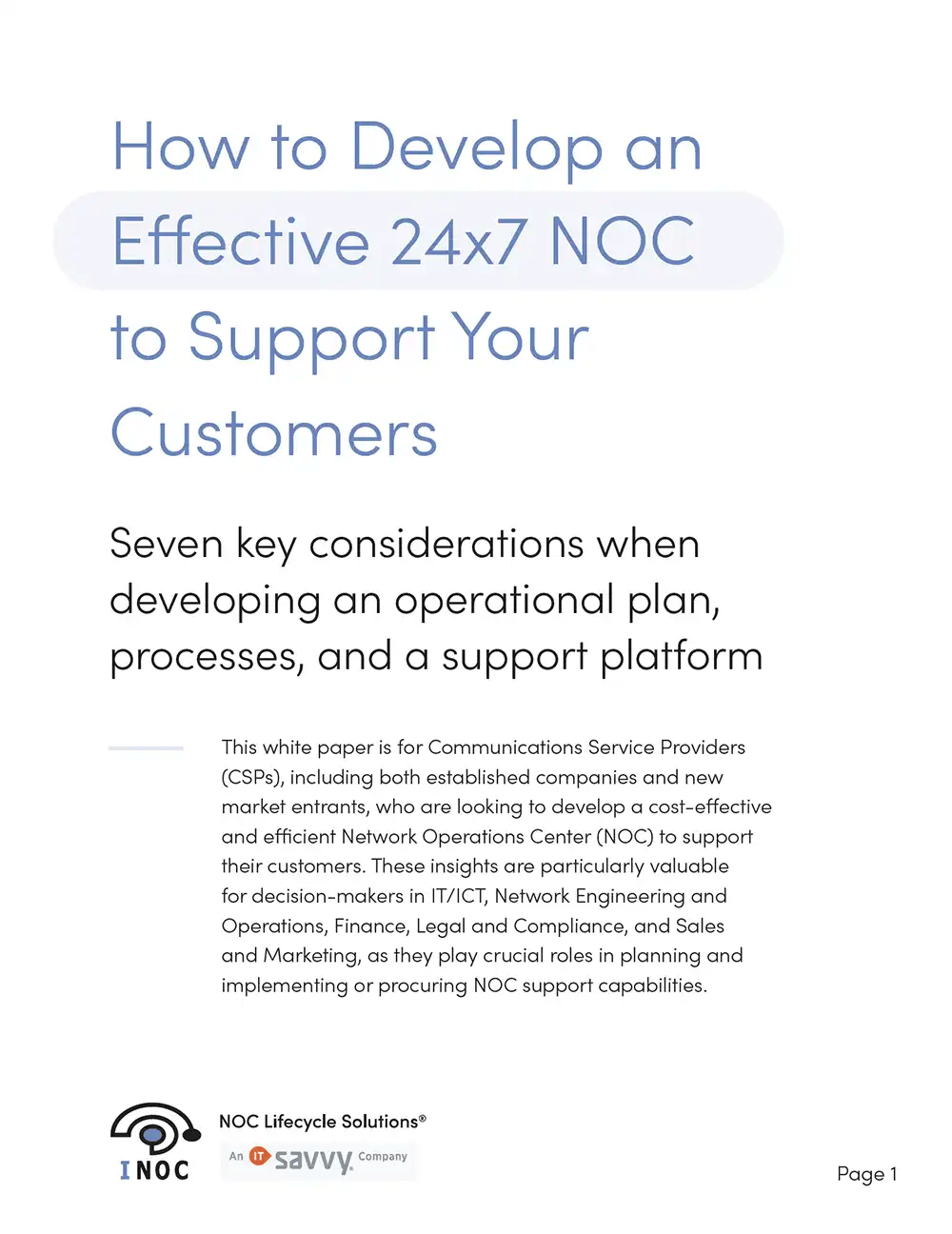

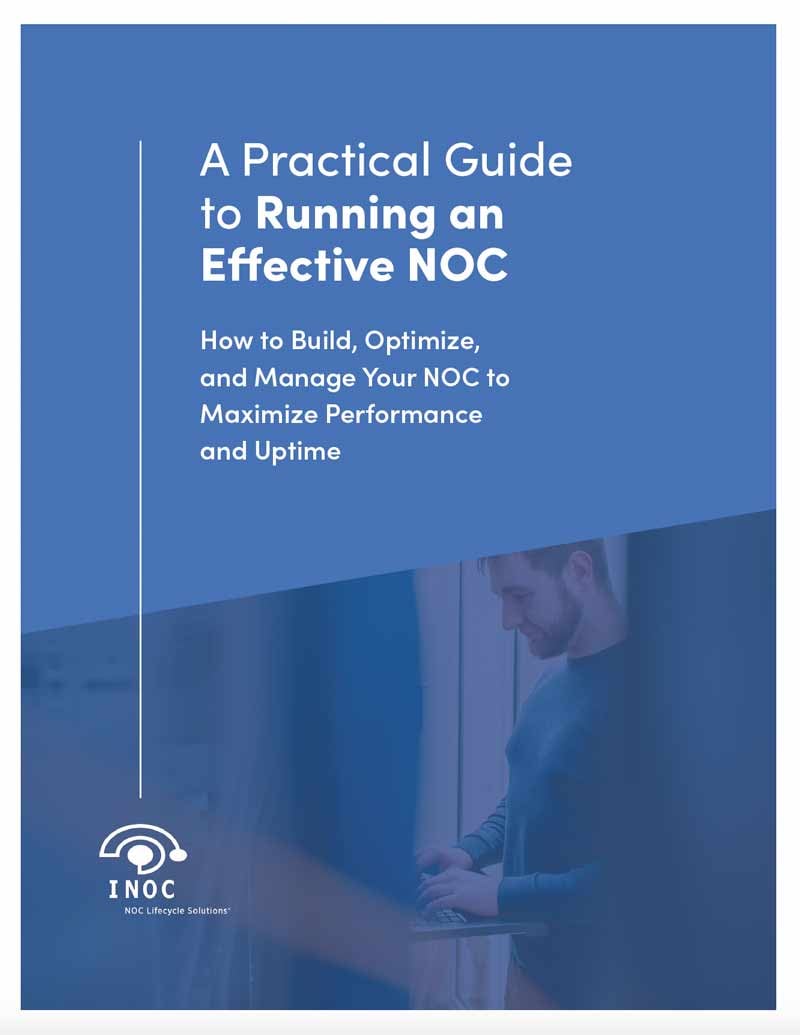
-images-0.jpg?height=2000&name=ino-WP-NOCPerformanceMetrics-01%20(1)-images-0.jpg)



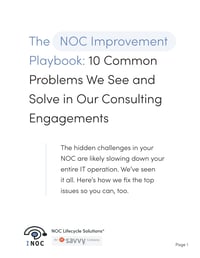

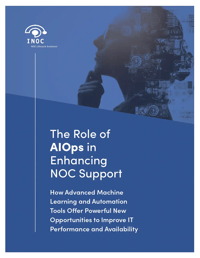

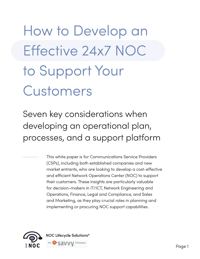
-images-0.jpg?width=200&height=259&name=ino-WP-NOCPerformanceMetrics-01%20(1)-images-0.jpg)